With the advent of more smart televisions, Samsung bought its new line of 7 series and 8 series to the market. Samsung has been the best TV brand for a long time and that has been reflected in the expectations and trust that customers have in the company. You might want to buy a new Samsung TV and you are confused between the Samsung 7 series and the Samsung 8 series. Don’t worry in this Samsung 7 Series vs 8 Series guide we will show a complete comparison between these two TVs and also explain to you the critical terms that you need to know when buying a TV.
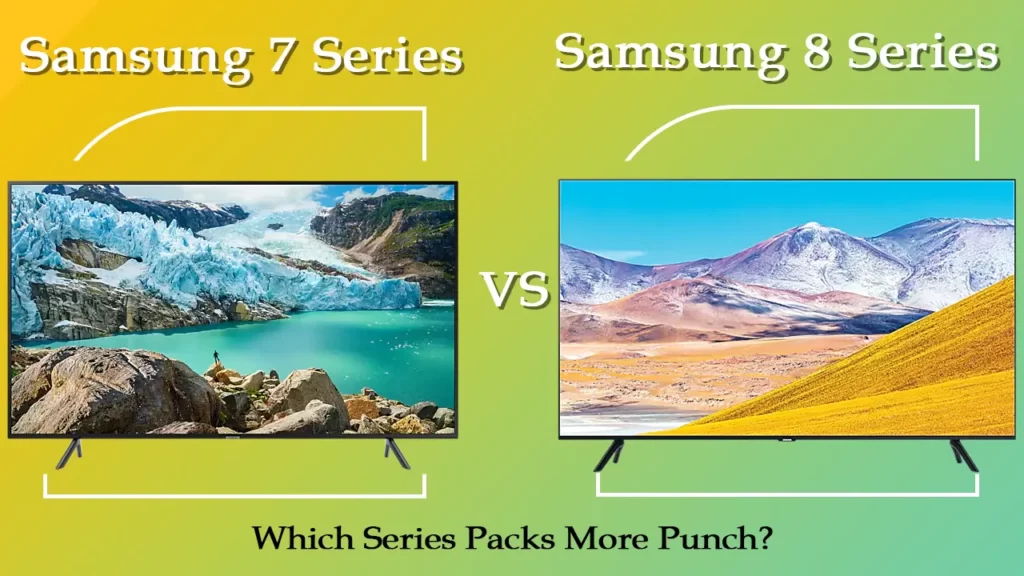
Physical Dimensions
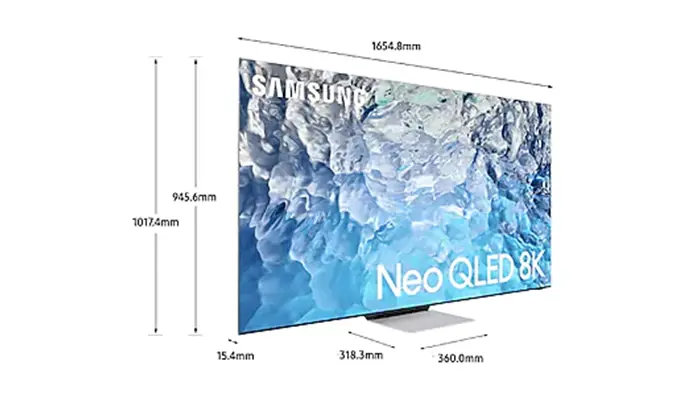
Both the Samsung 7 series and the Samsung 8 series have fairly the same dimensions.
Samsung always comes with a range of sizes while launching its television and these models aren’t any exceptions. These also have the same number of sizes as in any TV series. Also, you will find the models look the same, there is not any difference in the bezel size or the thickness of the TV sets. There are both wall mounting and tabletop options available with the models as well.
You get plastic bezels and plastic V stands with the TV which is good in terms of quality but the TV wobbles when they are supported on the V stands. The wobbling happened when we put our hands on the TV.
Display Quality
Display Quality is one of the most important aspects of the Television industry. Samsung has provided better display quality than most companies and continues to do that. Display Quality has numerous areas which we will compare one by one.
Ultra-High Definition
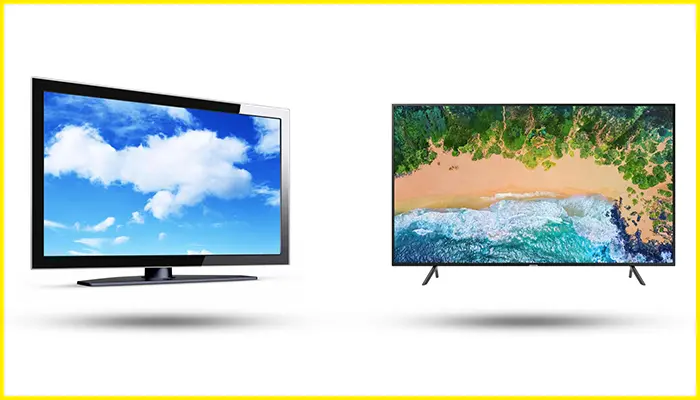
Both Televisions come with Ultra High-Definition picture quality and can show videos in 4K.
4K is a resolution of 3840 x 2160 pixels which shows you videos with high clarity which means you get more pixels in a screen. As each pixel represents a single color, the more pixels a screen has the more freedom it has in terms of generating a particular image. The Samsung 7 series and the Samsung 8 series can also upscale a lower-resolution video to 4K. This upscaling technique that Samsung uses is much more popular than any other company.
The Samsung 8 series have Crystal UHD technology which is Samsung’s in-house technology for better picture quality. Samsung uses this technology in its high-standard devices and it is the best feature from Samsung that delivers crystal clear images.
High Dynamic Range
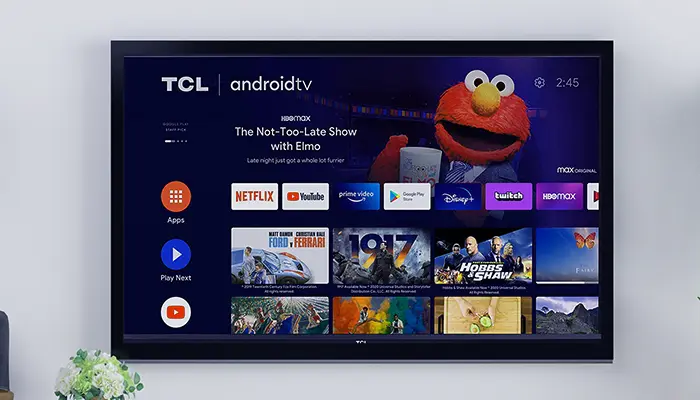
Both Televisions also have HDR capabilities.
High Dynamic Range or HDR is the capability of the TV to intelligently control the light and dark parts of an image. It allows for better pictures, so if a picture has more sunlight which is lowering the clarity of a particular area, then the TV will automatically lower the light to a certain level that all the areas of the picture are visible. This is more important in shots with more landscapes. Some models of the 8 series also have 4K HDR Extreme and some models of the 7 series have 4K HDR Pro which is of course better than other displays.
Contrast Ratio

The Samsung 8 series has a better contrast ratio than the Samsung 7 series.
While the former has a contrast ratio of 8,000,000:1, the latter only has a contrast ratio of 3,000,000:1. While a contrast ratio of million to one is considered good so the Samsung 8 series has a brilliant contrast ratio. The contrast ratio is the measurement of the brightest white and the darkest black in an image. It is the number of colors your display can show you in a particular frame. The more contrast in an image the better it looks in terms of color and saturation you can get in an image.
LED Local Dimming

The Samsung 8 series has LED Local Dimming but the Samsung 7 series does not have this.
Local Dimming is crucial when seeing darker images on the TV screen. The TV can turn off the LED backlights in areas that are dark which provides a better black color.
In OLED and Plasma TV Local dimming is called Full-array Local dimming. You get individual LED lights for individual pixels so, in dark areas, LED lights can turn off and give a dark environment. While in LCD TVs or LED-LCD TVs you get a white backlight that provides light to the LCD panel which then shows color. In dark areas, these LED lights turn off themselves to give a dark image and in the bright parts, they keep themselves lit. Because expensive TVs give you more number of Backlight LEDs you get more control of the image on the screen.
Refresh Rate
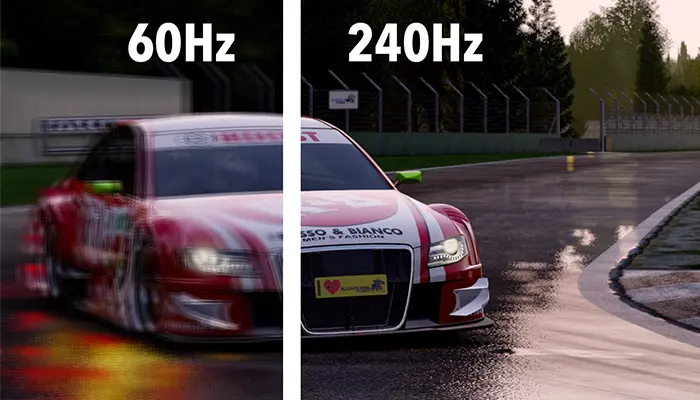
The Samsung 8 series delivers a 240Hz refresh rate while the Samsung 7 series delivers a 120Hz refresh rate.
Refresh rate is the speed of your TV screen to change the number of images in under a second. In a 120Hz display, you will get 120 frames in a second. Higher Refresh allows for less motion blur and more fluid and smooth animation. While 120Hz is a very nice amount of Refresh rate because most TVs come with a refresh rate of 60Hz, Samsung 7 series has double of that and the Samsung 8 series has four times that. Both the series support Auto Motion Plus which is a technology from Samsung to lower input in your television.
If you are a gamer and you looking to play games on these TVs you will happy to know that some of the models from both series support AMD FreeSync. FreeSync is a technology for AMD that lowers input lag in a system for faster gameplay and smooth animations.
Audio Quality
It is recommended that you use an external speaker for audio purposes because TV speakers are not that powerful so, you will not get a bass punch with these in-built speakers. Though the Samsung 7 series and the Samsung 8 series both have fairly newer audio technologies with the Samsung 8 series having an extra subwoofer along with two speakers.
The Samsung 7 series only has 2 speakers and lacks a subwoofer. You can feel the difference because the lack of a subwoofer causes low bass levels. Both speakers are clear and loud enough to make things audible in a big room. The sound output on some models even goes as high as 40W RMS while the typical sound output is 20W RMS.
You get Dolby Vision, Dolby Atmos, and DTS from each of these TVs. These are industry-leading and increase audio performance drastically in the devices. With an external speaker, you can also use these technologies and you will have great watching movies or playing games.
Ports, Connectivity, and Smart TV features
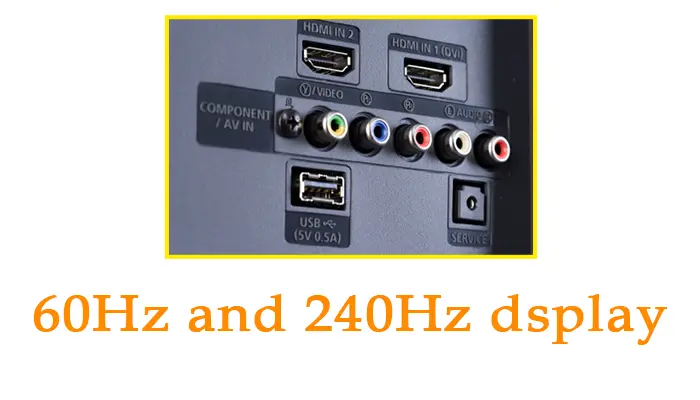
These Samsung TVs have all the ports that today’s modern TVs generally have. You get HDMI, USB, and Ethernet ports along with the traditional three-pin audio ports. The Samsung 7 series have a lesser number of HDMI ports compared to the Samsung 8 series. In terms of connectivity, both TVs can be connected to modern-day appliances such as smartphones, tablets, Smart speakers, etc. You get WIFI and Bluetooth included with the devices.
These TVs run on the Tizen operating system which is very intuitive and has many apps included and also downloadable. You get all the popular streaming apps pre-installed such as Netflix, Amazon Prime, Disney+, etc.
Line-ups in the series
You get three kinds of line-ups in the Samsung 7 series and the Samsung 8 series – MU, RU, and NU.
MU Line-up
The MU series have higher refresh rates, better picture clarity, and better sound output. The MU 7 series is better in terms of contrast ratio than the MU 8 series while the MU 8 series have better speakers and an extra subwoofer. You get local dimming with the MU 8 series only. These TVs are good for general watching and gaming.
RU Line-up
The RU series also has high contrast rates, but lower picture quality and lower sound output. Here both the Samsung 7 series and the Samsung 8 series have low-output speakers and lack a subwoofer. These have high contrast rates though and are good for visual experience with a decent amount of HDR. These TVs have additional FreeSync, VRR support, Dynamic Black EQ, and Game Enhance included. These are better for gaming purposes with an external speaker or headphones. Remember, the Samsung 7 series doesn’t support VRR and Freesync.
NU Line-up
This is the all-rounder line-up in the Samsung 7 series and the Samsung 8 series. The NU series has a good amount of HDR support with the Samsung 8 series has HDR plus. These have better sound output and high contrast rates. You don’t get FreeSync and VRR in Samsung 7 series but have all the RU Line-up features included in the Samsung 8 series. These are best for gaming as well as watching general television.
Samsung 7 Series vs 8 Series – The Verdict
The Samsung 7 and 8 series come with many features needed for a modern-day 4K LED TV. You get unmatched picture quality, sound quality, and high refresh rates. These TVs are intended both for the general audience and a gamer. You can also use it as a TV for watching News, Sports, Web series, and Movies along with a console Screen such as a PS5, PS4, and XBOX console.
The Samsung 8 series is certainly better in terms of higher contrast rates and better refresh rates. If you want a television for watching TV and sometimes playing gaming then go for the 7 series. If you want to watch television along with frequent gaming then opt for the 8 series, it is more costly than the 7 series but packs more punch.
Frequently Asked Questions
Which is better Samsung 8 series vs 7 series?
The Samsung 8 series is better than the 7 series because the 8 series have better picture quality, audio quality and higher refresh rates than the 7 series.
Is Samsung 8 series affordable?
Samsung 8 series is fairly costly seeing the features it has to offer. It is costlier than the 7 series. If you want an affordable option then go for the 7 series.
Does Samsung 8 series have high contrast ratio?
The Samsung 8 series has a contrast ratio of 8,000,000:1 which is very high for a LED TV, whereas the 7 series has a contrast ratio of only 3,000,000:1 which is also high than typical LED TVs.
Speaking of TVs, Vizio has been quite the trend recently but is it better than Samsung? Let’s find out: Vizio vs Samsung: Which Brand to Pick For Best 4k TVs This 2022?